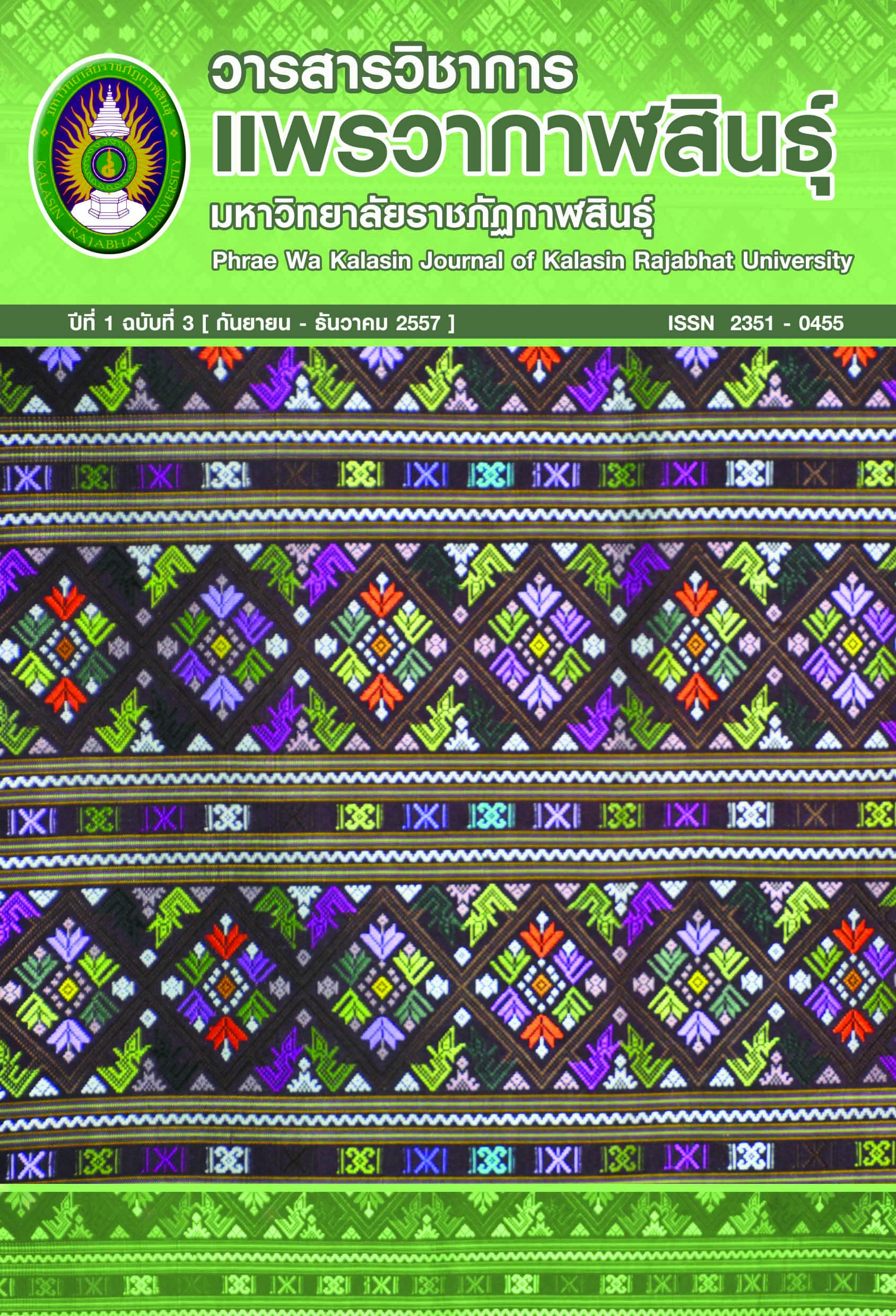Saw-Bang : Cultural Transmission Created and Played by Bokaew Villagers at Tambon Bokaew, Amphoe Nakhhu Kalasin Province
Main Article Content
Abstract
การวิจัยครั้งนี้มีวัตถุประสงค์ ดังนี้ 1) เพื่อศึกษาการประดิษฐ์ซอบั้งของชาวบ้านบ่อแก้ว ตำบลบ่อแก้ว อำเภอนาคู จังหวัดกาฬสินธุ์ 2) เพื่อศึกษาการบรรเลงซอบั้งของชาวบ้านบ่อแก้ว ตำบลบ่อแก้ว อำเภอนาคู จังหวัดกาฬสินธุ์ 3) เพื่อศึกษาบทบาทซอบั้งของชาวบ้านบ่อแก้ว ตำบลบ่อแก้ว อำเภอนาคู จังหวัดกาฬสินธุ์ ประชากรที่ศึกษาได้แก่ประชากรที่อาศัยในหมู่บ้านบ่อแก้ว ตำบลบ่อแก้ว อำเภอนาคู จังหวัดกาฬสินธุ์ ผู้วิจัยได้เลือกกลุ่มตัวอย่างแบบเจาะจง โดยใช้เครื่องมือประกอบด้วยแบบสำรวจ แบบสัมภาษณ์ แบบสังเกต และแนวทางการสนทนากลุ่ม ผลการวิจัยมีดังนี้ วัสดุและอุปกรณ์การประดิษฐ์ซอบั้งของชาวบ้านบ่อแก้วประกอบด้วยไม้ไผ่ มีดโต้มีดไส มีดเจาะ เหล็กซี สายเบรกรถจักรยาน สายเอ็นไนลอน สายพลาสติก และยางไม้ต้นซาด โดยมีขั้นตอนและวิธีการประดิษฐ์ซอบั้งที่สำคัญคือการเลือกไม้ไผ่การวัดระยะความยาวของซอบั้งไม้ไผ่ การไสเปลือกไม้ไผ่ให้มีความบางตามต้องการการขึ้นสายซอบั้งไม้ไผ่ การเจาะช่องขยายเสียงและการประดิษฐ์คันชัก ในด้านระบบเสียงซอบั้งของชาวบ้านบ่อแก้วพบว่ามีเสียงหลักที่ใช้ในการบรรเลงบทเพลงอยู่ 6 เสียงคือ F#A#BC#EF# ซึ่งเป็นระบบเสียงห้าเสียง (Pentatonic Scale) โดยอยู่ในโครงสร้าง ของบันไดเสียง F#Minor Pentatonic Scale การบรรเลงจะสีทั้งสองสายพร้อมกันโดยสายที่หนึ่งเป็นสายบรรเลงทำนอง ส่วนสายที่สองเป็นสายเสียงประสานยืน (Drone) โดยมีทำนองเพลงที่บรรเลงคือลายล่องขวง ลายลำภูไท ลายลำให้พร ลายเดินดงและลายสุดสะแนน ส่วนบทบาทซอบั้งของชาวบ้านบ่อแก้วที่พบคือบทบาทของซอบั้งในบริบทเฉพาะกลุ่มบุคคลในชุมชน และบทบาทของซอบั้งในบริบทเชิงพิธีกรรมในชุมชน
The unique construction process and cultural role played by a traditional musical instrument called the Saw-Bang are the subjects of this study. The Saw-Bang is a fiddle like instrument typically found in villages of Northeast Thailand. This report focuses on villagers in Borkeaw Sub District, Nakhu District, in Kalasin Province and discusses the production process and materials they use in the creation of the Saw-Bang. Also presented are observations on how the production process influences the melody of the instrument, when played by different local villagers, and the overall cultural role of the Saw-Bang. The population in the study consisted of villagers selected by purposive sampling in Borkeaw Sub District, Nakhu District, Kalasin Province. The research instruments were a survey form, an interview form, observation form, and group conversation. The results of the study show that the materials used in the production process of the Saw-Bang are a bamboo stick, steel knife, shaver, wood piercer, brake cable, nylon cable, plastic cable, and the gum from local trees called “Sard”. The crucial steps in the production process are selection of bamboo stick, measurement of the stick, shaving, line setting, piercing of an amplifier slot, and making of the bows. With respect to musicology, the pentatonic scale is used including F#, A#, BC#, EF#. The scale is in the structure of the F# minor pentatonic scale. Two lines of the instrument are played harmonically; one line serves as a rhythm maker, and the other a drone. The instrument is normally used when singing traditional songs such as Lai-longkuang, Lai-lumphuthai, Lai-lumhaipon, Lai-derndong, and lai-soodsanan. Lastly, a study of Saw-Bang’s social role found that both individual and community ceremonial roles are related to the instrument.
Article Details
Section
Articles (บทความ)
